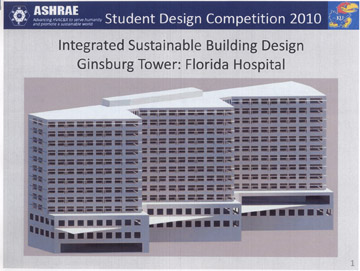Architectural Engineering Team Earns Second Place for Sustainable Design
An innovative, energy-efficient design for a hospital expansion earned high honors in an international competition for a team of students from the University of Kansas School of Engineering.
Four architectural engineering students — spring 2010 graduates Garrett Russell and Jeff Seger, fall 2010 graduate Derek Gay and spring 2009 graduate Ross Farris — earned second place in the integrated sustainable design category of the 2010 American Society of Heating, Refrigerating and Air-Conditioning Engineers student project competition.
Teams were challenged to design a 15-story addition to an Orlando, Fla., hospital that approaches net-zero energy use — meaning the facility creates onsite as much energy as it consumes. The KU team’s solution incorporated a number of unique features that saved, reused or generated energy.

“We included some newer technologies that are not used that frequently, like chilled beams to cool the air,” Gay said.
Chilled beams take in, circulate and cool air more efficiently than a standard air-handling unit, Gay said. The team also included special ventilation systems for patient rooms that maximize the use of outdoor air when the temperature and humidity allow.
Each team member focused on a specific area of the project, in addition to the general requirements. Seger designed an energy system that used one fuel source to generate electricity, steam and hot water. Farris, who just completed his master’s of architecture degree at KU, focused mainly on the architectural work and the patient care rooms. Russell addressed fire protection and central ventilation systems. Gay was in charge of the facility’s renewable energy sources and water conservation.
“I took care of the photovoltaic arrays — essentially, the setup of the building’s solar energy intake — the use of solar-thermal to heat water (through collectors) on the roof, condensation recovery from air handlers and tallying the Leadership in Energy and Environmental Design credits” that predict how environmentally friendly the building will be, Gay said.
The facility’s location in a hot, humid area also added to the challenge.
“It’s more difficult because you have to dehumidify more,” Gay said. “Cooling is more expensive (there) than heating because it’s harder to cool something down than heat it up. So it poses a lot more challenges in a hot and humid climate than in a more mild one.”
Although each student had his own area of emphasis, Brian Rock, associate professor of civil, environmental and architectural engineering and faculty adviser for the project, said the group still did a wonderful job of pulling a diverse set of skills together to make a great design and an outstanding team.
“All team members brought extra knowledge in their specialized areas,” said Rock, a fellow of ASHRAE. “That helped broaden the package, and we went beyond what was asked for in the competition. This type of success demonstrates that graduates of the KU School of Engineering, and the architectural engineering program, are quite diverse. They are ready to pursue what they are interested in, and that can be in a wide variety of areas.”
The team will receive the award in January during the 2011 ASHRAE Winter Meeting in Las Vegas.